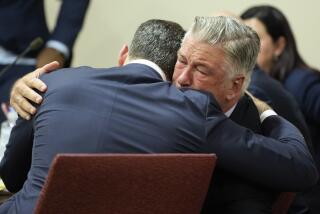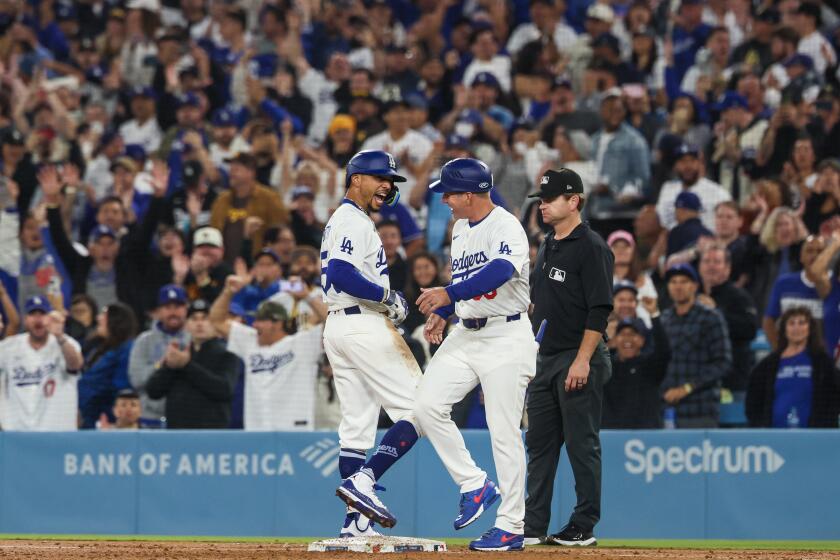A Cynical â93, but Was Verdict Guilty? : And so I offer Willâs error as evidence that 1993, for all its trials and tribulations, really wasnât as bad as you thought.
A Los Angeles jury decided that smashing Reginald Dennyâs skull with a brick did not constitute assault with a deadly weapon . . . --Columnist George Will in Newsweek, Dec. 17, 1993 Outrageous, isnât it? You saw the video. You saw Damian Williams heave the brick that smashed Reginald Dennyâs skull. You saw Williamsâ little victory dance. And now the estimable George Will, reviewing 1993 with a deadpan delivery of facts and observations, reminds us that an infamous jury amazingly concluded Williams was innocent of assault with a deadly weapon.
But hold on a second. Before you get mad all over again, remember you shouldnât believe everything you read.
This time, George Will didnât get his facts straight.
You know George. If you donât read Newsweek, youâve seen him on âThis Week With David Brinkley.â A button-down conservative. A big Orioles fan. Heâs the WASPiest, nerdiest pundit in Washington--and one of the best. You may or may not agree with his opinions, but itâs hard not to respect his thinking and his prose.
So it may be telling that Will would botch a routine fact in a column titled â1993: Natureâs Hysterics, and More.â
His mistake is a common one and, no doubt, an honest one. But it may reveal how Will and others angry with the Williams verdict arenât immune from hysterics themselves. And so I offer Willâs error as evidence that 1993, for all its trials and tribulations, really wasnât as bad as you thought.
George, please pay attention: The Williams jury did not decide that smashing Dennyâs skull with a brick wasnât assault with a deadly weapon--or ADW, as the cops call it. The jury decided that Williamsâ felonious assault, as horrible as it was, did not constitute either attempted murder or aggravated mayhem (maiming). The jury found him guilty of the lesser felony of mayhem, as well as four misdemeanor counts of assault.
The difference is huge.
ADW, in and of itself, isnât a big-time felony. The maximum prison term is four years. By contrast, the maximum sentence for attempted murder or aggravated mayhem is life imprisonment.
Williams wasnât charged with ADW in the Denny beating, prosecutors explain, because he faced far more serious charges. Under sentencing rules, prosecutors say, a charge of ADW would have been pointless. As it was, the much-maligned jury convicted Williams of crimes that enabled Judge John W. Ouderkirk to impose a 10-year sentence.
This may seem like nit-picking. After all, confusing ADW with attempted murder is easy to do. Moreover, in the attacks on four other individuals, Williams was indeed acquitted of ADW in favor of misdemeanor assaults.
Nonetheless, Willâs mistake will reach millions of readers, perpetuating the notion that the Williams jury had no logical basis for its ruling.
Critics who found the Williams verdict too lenient offer it as a be-all, end-all symbol of whatâs wrong with America. Race relations are a mess and the criminal justice system is a joke, they say. These are certainly great sources of consternation.
In this climate, Willâs error should be seen as a symptom of cynicism--a favorite pastime after the Denny verdict.
The misconception has been popularized in a clever but inaccurate political cartoon by Randy Wicks of the Newhall Signal. Wickâs work, which has been reproduced on T-shirts, depicts three âAssault Weapons in L.A.â
The word âMeanâ appears above the image of a bloody knife. âMeanerâ appears above a smoking gun. Above the bloody brick is the punch line: âMisdemeanor.â
Itâs pretty funny, but the fact remains that Williamsâ brick was implicated in a felony.
Political cartoonists engage in parody, so Wicks probably knows better. Willâs intent is serious, not satiric. However, had Will substituted the words attempted murder for assault with a deadly weapon , the statement would not seem so mind-boggling; after all, intent is hard to prove.
For all their inaccuracies, Wicksâ cartoon and Willâs column accurately reflected the public mood of outrage. Expectations of an attempted murder conviction left an angry public saying Williams was âgetting off.â Long before Willâs column appeared, I talked with three people who also confused ADW with attempted murder. Two were white, one was black. All were outraged that Williams didnât get hammered with the maximum penalty.
The point isnât whether Williamsâ punishment fits his crime, but whether the jury had reasonable grounds for its verdict.
The story is rich with irony. It is ironic that the video that so angered us evidently persuaded 12 citizens that there was a reasonable doubt as to whether Williams intended to kill or permanently disfigure his victim. If that was his intent, why didnât Williams continue his violent attack rather than do his nasty jig? The video that nailed Williams as one of the culprits, it seems, supported the lower mayhem charge.
It is also ironic that the good Samaritans who saved Dennyâs life saved Williamsâ bacon. Had they not arrived, Williams likely would have faced a murder charge--a point prosecutors made often.
Dennyâs survival didnât help the case against Williams. To the contrary, Dennyâs decision to hug the mothers of Williams and co-defendant Henry Watson may have helped put the jury in a more lenient frame of mind.
So you can look at 1993 a couple of ways. Perhaps it left a bitter taste. But if you tend to remember the smirk of Damian Williams, donât forget the forgiving embrace of Reginald Denny.
The brick was â92; the hug was â93.
Hereâs to the hope for a better â94.
Scott Harrisâ column appears Tuesday, Thursday and Sunday. Readers may write Harris at The Times Valley Edition, 20000 Prairie St., Chatsworth, Calif. 91311.
More to Read
Go beyond the scoreboard
Get the latest on L.A.'s teams in the daily Sports Report newsletter.
You may occasionally receive promotional content from the Los Angeles Times.










